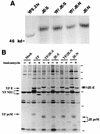Yellow fever/Japanese encephalitis chimeric viruses: construction and biological properties
- PMID: 10074160
- PMCID: PMC104070
- DOI: 10.1128/JVI.73.4.3095-3101.1999
Yellow fever/Japanese encephalitis chimeric viruses: construction and biological properties
Abstract
A system has been developed for generating chimeric yellow fever/Japanese encephalitis (YF/JE) viruses from cDNA templates encoding the structural proteins prM and E of JE virus within the backbone of a molecular clone of the YF17D strain. Chimeric viruses incorporating the proteins of two JE strains, SA14-14-2 (human vaccine strain) and JE Nakayama (JE-N [virulent mouse brain-passaged strain]), were studied in cell culture and laboratory mice. The JE envelope protein (E) retained antigenic and biological properties when expressed with its prM protein together with the YF capsid; however, viable chimeric viruses incorporating the entire JE structural region (C-prM-E) could not be obtained. YF/JE(prM-E) chimeric viruses grew efficiently in cells of vertebrate or mosquito origin compared to the parental viruses. The YF/JE SA14-14-2 virus was unable to kill young adult mice by intracerebral challenge, even at doses of 10(6) PFU. In contrast, the YF/JE-N virus was neurovirulent, but the phenotype resembled parental YF virus rather than JE-N. Ten predicted amino acid differences distinguish the JE E proteins of the two chimeric viruses, therefore implicating one or more residues as virus-specific determinants of mouse neurovirulence in this chimeric system. This study indicates the feasibility of expressing protective antigens of JE virus in the context of a live, attenuated flavivirus vaccine strain (YF17D) and also establishes a genetic system for investigating the molecular basis for neurovirulence determinants encoded within the JE E protein.
Figures






References
-
- Calisher C H, Karabatsos N, Dalrymple J M, Shope R E, Porterfield J S, Westaway E G, Brandt W E. Antigenic relationships between flaviviruses as determined by cross-neutralization tests with polyclonal antisera. J Gen Virol. 1989;70:37–43. - PubMed
-
- Cecilia D, Gould E A. Nucleotide changes responsible for loss of neuroinvasiveness in Japanese encephalitis virus neutralization-resistant mutants. Virology. 1991;181:70–77. - PubMed
-
- Chambers T J, Hahn C S, Galler R, Rice C M. Flavivirus genome organization, expression and replication. Annu Rev Microbiol. 1990;44:649–688. - PubMed
-
- Chambers T J, McCourt D W, Rice C M. Production of yellow fever virus proteins in infected cells: identification of discrete polyprotein species and analysis of cleavage kinetics using region-specific polyclonal antisera. Virology. 1990;177:159–174. - PubMed
Publication types
MeSH terms
LinkOut - more resources
Full Text Sources
Other Literature Sources

